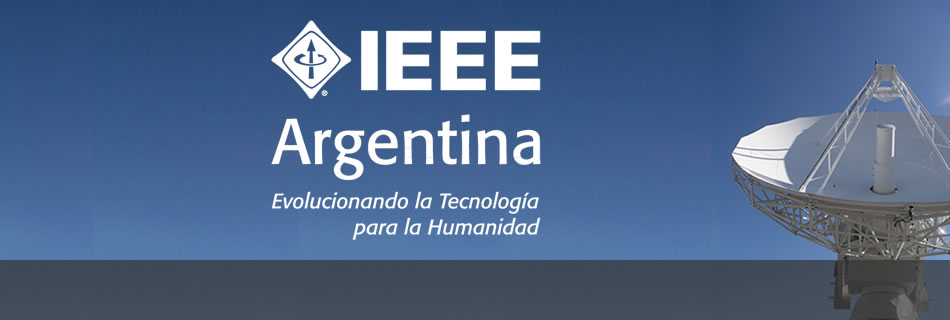Noticias y Actividades
Publicado el 20/03/2012
 IEEE AR BTS. APS, EMCS - Seminario ‘Smart Antennas’
IEEE AR BTS. APS, EMCS - Seminario ‘Smart Antennas’
Dr. Tapan K. Sarkar - 14 al 16 de mayo de 2012 (9 hs.), en FIUBA, Buenos Aires
Los Capítulos Argentinos de las Sociedades IEEE BTS Broadcast Technology y conjunto APS Antennas and Propagation y EMCS Electromagnetic Compatibility, junto con la Facultad de Ingeniería de la UBA invitan a participar del Seminario ‘Smart Antennas’ que dictará el Dr. Tapan K. Sarkar, IEEE Fellow y Disertante Distinguido, durante su visita a la Argentina y según se detalla a continuación.
Seminario ‘Smart Antennas’
* Fecha y hora: Lunes 14, martes 15 y miércoles 16 de mayo de 2012, de 17:00 a 20:00.
* Lugar: FIUBA, Facultad de Ingeniería de la Universidad de Buenos Aires
Paseo Colón 850, Buenos Aires (Salón del Consejo Directivo)
* Inscripción
Esta actividad es de acceso libre y gratuito.
Agradeceremos inscripción previa, completando el formulario disponible en
http://www.ieee.org.ar/sistemainscripciones/InscripcionSolicitud.asp?idevento=97
Alternativamente, por e-mail a sec.argentina@ieee.org citando 'Seminario Antenas’, un teléfono de contacto y si es o no socio IEEE, o por teléfono a IEEE / CICOMRA (011) 4325 8839.
Abstract
The term smart antenna is often used in mobile communications to describe an adaptive process designed to improve the capacity of a base station by focusing the radiated electromagnetic energy on transmit while also improving the gain pattern on receive from a mobile.
Here, the transmitted signals from a base station are spatially directed to an intended mobile.
In addition, the receive gain of the base station is also increased by spatially forming a beam along the direction of a mobile which is on a transmit mode.
In this way the capacity of a base station can be increased as it can serve many mobile units simultaneously by directing a beam along each one of them. However, this promise of increased capacity through space division multiplexing can further be enhanced if one understands the true nature of an antenna (the source of radiating and/or the sensor of electromagnetic energy) which is the central point of this methodology.
An antenna may be considered to be a device that maps spatial-temporal signals into the time domain, thus making them available for further analysis in a digital signal processor. In this philosophical framework, an ideal antenna is one that converts the spatial-temporal signals arriving at an antenna into a temporal signal without any distortion.
Hence, there is a tacit assumption that no information is destroyed by the antenna.
This may be true when dealing with narrowband signals, but when considering the transmission of broadband signals, even a small radiator called a Hertzian dipole operating in free space behaves differently on transmit than it does on receive.
On transmit a finite sized dipole antenna double differentiates the current induced on it whereas on receive it performs a single differentiation of the incident field to produce the open circuit voltages.
One of the objectives of the short course will be to illustrate the coupling of the electromagnetic analysis with the signal processing methodology to deal with broad band signals.
Hence, the temporal and spatial properties of an antenna are intimately related and the term smart antenna is used to imply that one is dealing appropriately with this dual spatial and temporal properties of an antenna on both transmit and receive.
Another objective of this course is to explain the basic difference between adaptive antennas and adaptive signal processing.
Wherein for the former an antenna acts as a spatial filter, and therefore processing occurs in the angular domain, while in adaptive processing analysis is usually carried out in the temporal domain.
To identify whether one is dealing with adaptive antennas or adaptive signal processing one should answer the following simple question, “For a narrowband communication can the adaptive system separate a desired signal from its coherent multipath components?”
In this scenario, there is not only a signal, but also multipath components that are correlated with the desired signal and interacts (in either a constructive or destructive fashion) with the signal.
Only an adaptive antenna can isolate the desired signal from its coherent multipath, as the information on how to separate them is contained in the angle of arrival, i.e. in the spatial domain.
There is little information in the temporal domain for this case.
The signal processing community sometimes views an antenna as a temporal channel whereas the practitioners of electromagnetics always consider an antenna to be a spatial filter.
We want to distinguish between these disjoint temporal and spatial properties by adding the term Smart Antennas.
By the term Smart Antennas we imply that we are merging these two distinct methodologies to provide better systems.
An additional advantage to using this coupled spatial-temporal methodology is that we have a well-established mathematical tool, which treats in an exact way, this space-time continuum.
This mathematical framework for such a system is described by one of the oldest sets of equations in mathematical physics, equations that have withstood the test of erosion and corrosion of time. Even the advent of relativity has had little effect on them. This analytical framework is given by Maxwell’s equations.
A third objective will be to illustrate procedures for adaptive processing using directive elements in a conformal array.
Under the current philosophy, it is uncommon to use directive elements in a phased array or antenna elements that are not uniformly spaced.
The current thinking is that if one does not use omni-directional antenna elements, then it may not be possible to scan over wide angles.
In order to increase the directive gain of the phased array, one increases the total number of elements by hundreds or even thousands.
This increases the cost significantly as one needs an analog-to-digital converter (ADC) at each antenna element, in addition to a complete receiver channel for down conversion of the radio frequency signal to base band.
The cost and complexity of a phased array can be dramatically reduced if we employ directive antenna elements on a conformal surface.
In addition, individual antenna elements may be non-uniformly spaced or the conformal array can even be non-planar.
To treat such general array configurations we describe an electromagnetic preprocessing technique using an array transformation matrix which broadens the fundamental principles of adaptive antennas.
Here we address phased array applications utilizing directive elements that may be nonuniformly spaced and operating in the presence of near field scatterers.
We also present the Direct Data Domain Least Squares (D3LS) approach to estimate the signal in the presence of jammer interference, clutter and thermal noise. In this technique no statistical information about the clutter is necessary.
Also, since no covariance matrix needs to be formed in this procedure, the process can be implemented in real time on an inexpensive digital signal processing (DSP) chip.
We also present an extension of this technique to include traditional statistical processing when dealing with Space Time Adaptive Processing (STAP).
One unique topic in this course is a multistage analysis procedure that combines electromagnetic analysis with signal processing.
Initially, electromagnetic principles are applied to compensate for the effects of mutual coupling between antenna elements, including the effect of nonuniformity in the spacing between the elements, and the presence of near field scatterers.
Then a direct data domain methodology is implemented to yield the signal of interest.
A deterministic model for the signal of interest yields a lower value for the Cramer-Rao bound than stochastic methods.
In this approach, no statistical information about the interference environment is necessary.
This makes it possible to perform real time processing in a dynamic environment.
These principles will be illustrated for space-time adaptive processing of real experimental data obtained from an airborne multi-channel radar system.
Orador: Tapan K. Sarkar
 Tapan K. Sarkar received the B.Tech. degree from the Indian Institute of Technology, Kharagpur, in 1969, the M.Sc.E. degree from the University of New Brunswick, Fredericton, NB, Canada, in 1971, and the M.S. and Ph.D. degrees from Syracuse University, Syracuse, NY, in 1975.
Tapan K. Sarkar received the B.Tech. degree from the Indian Institute of Technology, Kharagpur, in 1969, the M.Sc.E. degree from the University of New Brunswick, Fredericton, NB, Canada, in 1971, and the M.S. and Ph.D. degrees from Syracuse University, Syracuse, NY, in 1975.
From 1975 to 1976, he was with the TACO Division of the General Instruments Corporation.
He was with the Rochester Institute of Technology, Rochester, NY, from 1976 to 1985.
He was a Research Fellow at the Gordon McKay Laboratory, Harvard University, Cambridge, MA, from 1977 to 1978.
He is now a Professor in the Department of Electrical and Computer Engineering, Syracuse University.
His current research interests deal with numerical solutions of operator equations arising in electromagnetics and signal processing with application to system design.
He obtained one of the “best solution” awards in May 1977 at the Rome Air Development Center (RADC) Spectral Estimation Workshop.
He received the Best Paper Award of the IEEE Transactions on Electromagnetic Compatibility in 1979 and in the 1997 National Radar Conference.
He has authored or coauthored more than 300 journal articles and numerous conference papers and 32 chapters in books and fifteen books, including his most recent ones, Iterative and Self Adaptive Finite-Elements in Electromagnetic Modeling (Boston, MA: Artech House, 1998), Wavelet Applications in Electromagnetics and Signal Processing (Boston, MA: Artech House, 2002), Smart Antennas (IEEE Press and John Wiley & Sons, 2003), History of Wireless (IEEE Press and John Wiley & Sons, 2005), Physics of Multiantenna Systems and Broadband Adaptive Processing (John Wiley & Sons, 2007), Parallel Solution of Integral Equation-Based EM Problems in the Frequency Domain (IEEE Press and John Wiley & Sons, 2009), and Time and Frequency Domain Solutions of EM Problems Using Integral Equations and a Hybrid Methodology (IEEE Press and John Wiley & Sons, 2010).
Dr. Sarkar is a Registered Professional Engineer in the State of New York.
He received the College of Engineering Research Award in 1996 and the Chancellor’s Citation for Excellence in Research in 1998 at Syracuse University.
He was an Associate Editor for feature articles of the IEEE Antennas and Propagation Society Newsletter (1986-1988), Associate Editor for the IEEE Transactions on Electromagnetic Compatibility (1986-1989), Chairman of the Inter-commission Working Group of International URSI on Time Domain Metrology (1990–1996), distinguished lecturer for the IEEE Antennas and Propagation Society from (2000-2003) and (2011-present), Member of Antennas and Propagation Society ADCOM (2004-2007), on the board of directors of ACES (2000-2006), vice president of the Applied Computational Electromagnetics Society (ACES), and a member of the IEEE Electromagnetics Award board (2004-2007), and an associate editor for the IEEE Transactions on Antennas and Propagation (2004-2010).
He is also on the editorial board of Digital Signal Processing – A Review Journal, Journal of Electromagnetic Waves and Applications and Microwave and Optical Technology Letters.
He is the chair of the International Conference Technical Committee of IEEE Microwave Theory and Techniques Society # 1 on Field Theory and Guided Waves. He is listed by ISI among the top 250 of most referenced authors in this field.
He is an IEEE Fellow since 1992.
He received Docteur Honoris Causa both from Universite Blaise Pascal, Clermont Ferrand, France in 1998 and from Politechnic University of Madrid, Madrid, Spain in 2004.
He received the medal of the friend of the city of Clermont Ferrand, France, in 2000.
http://www.lcs.syr.edu/faculty/sarkar
*** Para información sobre más actividades del Dr. Tapan K. Sarkar en Buenos Aires ver aqui
Destacados











